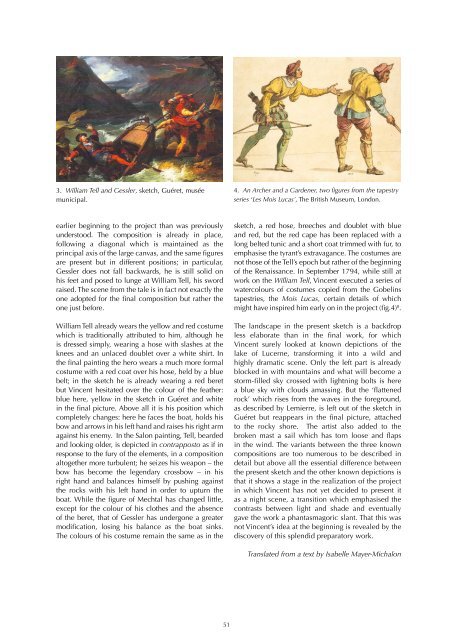You also want an ePaper? Increase the reach of your titles
YUMPU automatically turns print PDFs into web optimized ePapers that Google loves.
3. William Tell and Gessler, sketch, Guéret, musée<br />
municipal.<br />
4. An Archer and a Gardener, two figures from the tapestry<br />
series ‘Les Mois <strong>Luc</strong>as’, The British Museum, London.<br />
earlier beginning to the project than was previously<br />
understood. The composition is already in place,<br />
following a diagonal which is maintained as the<br />
principal axis of the large canvas, and the same figures<br />
are present but in different positions; in particular,<br />
Gessler does not fall backwards, he is still solid on<br />
his feet and posed to lunge at William Tell, his sword<br />
raised. The scene from the tale is in fact not exactly the<br />
one adopted for the final composition but rather the<br />
one just before.<br />
William Tell already wears the yellow and red costume<br />
which is traditionally attributed to him, although he<br />
is dressed simply, wearing a hose with slashes at the<br />
knees and an unlaced doublet over a white shirt. In<br />
the final painting the hero wears a much more formal<br />
costume with a red coat over his hose, held by a blue<br />
belt; in the sketch he is already wearing a red beret<br />
but Vincent hesitated over the colour of the feather:<br />
blue here, yellow in the sketch in Guéret and white<br />
in the final picture. Above all it is his position which<br />
completely changes: here he faces the boat, holds his<br />
bow and arrows in his left hand and raises his right arm<br />
against his enemy. In the Salon painting, Tell, bearded<br />
and looking older, is depicted in contrapposto as if in<br />
response to the fury of the elements, in a composition<br />
altogether more turbulent; he seizes his weapon – the<br />
bow has become the legendary crossbow – in his<br />
right hand and balances himself by pushing against<br />
the rocks with his left hand in order to upturn the<br />
boat. While the figure of Mechtal has changed little,<br />
except for the colour of his clothes and the absence<br />
of the beret, that of Gessler has undergone a greater<br />
modification, losing his balance as the boat sinks.<br />
The colours of his costume remain the same as in the<br />
sketch, a red hose, breeches and doublet with blue<br />
and red, but the red cape has been replaced with a<br />
long belted tunic and a short coat trimmed with fur, to<br />
emphasise the tyrant’s extravagance. The costumes are<br />
not those of the Tell’s epoch but rather of the beginning<br />
of the Renaissance. In September 1794, while still at<br />
work on the William Tell, Vincent executed a series of<br />
watercolours of costumes copied from the Gobelins<br />
tapestries, the Mois <strong>Luc</strong>as, certain details of which<br />
might have inspired him early on in the project (fig.4) 8 .<br />
The landscape in the present sketch is a backdrop<br />
less elaborate than in the final work, for which<br />
Vincent surely looked at known depictions of the<br />
lake of <strong>Luc</strong>erne, transforming it into a wild and<br />
highly dramatic scene. Only the left part is already<br />
blocked in with mountains and what will become a<br />
storm-filled sky crossed with lightning bolts is here<br />
a blue sky with clouds amassing. But the ‘flattened<br />
rock’ which rises from the waves in the foreground,<br />
as described by Lemierre, is left out of the sketch in<br />
Guéret but reappears in the final picture, attached<br />
to the rocky shore. The artist also added to the<br />
broken mast a sail which has torn loose and flaps<br />
in the wind. The variants between the three known<br />
compositions are too numerous to be described in<br />
detail but above all the essential difference between<br />
the present sketch and the other known depictions is<br />
that it shows a stage in the realization of the project<br />
in which Vincent has not yet decided to present it<br />
as a night scene, a transition which emphasised the<br />
contrasts between light and shade and eventually<br />
gave the work a phantasmagoric slant. That this was<br />
not Vincent’s idea at the beginning is revealed by the<br />
discovery of this splendid preparatory work.<br />
Translated from a text by Isabelle Mayer-Michalon<br />
51
















